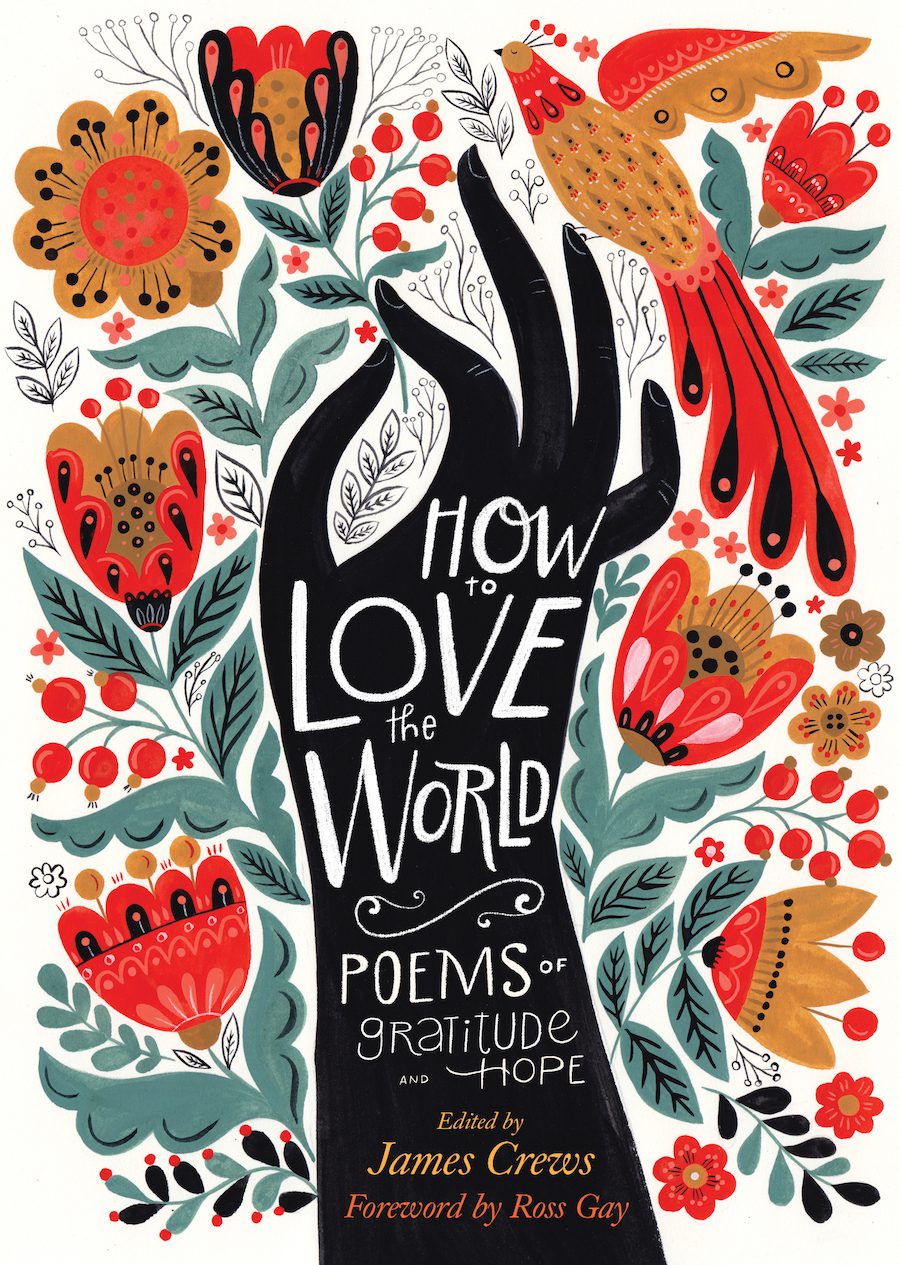We are thrilled to bring you this exclusive first look at the cover of How to Love the World: Poems of Gratitude and Hope, edited by James Crews and forthcoming from Storey Publishing on April 13, 2021.
More and more people are turning to poetry as an antidote to divisiveness, negativity, anxiety, and the frenetic pace of life. How to Love the World offers readers uplifting, deeply felt, and relatable poems by well-known poets from all walks of life and all parts of the US, including Joy Harjo, Donald Hall, Naomi Shihab Nye, Ross Gay, Tracy K. Smith, and others. The work of these poets captures the beauty, pleasure, and connection readers hunger for. How to Love the World, which contains new works by Ted Kooser, Mark Nepo, and Jane Hirshfield, invites readers to use poetry as part of their daily gratitude practice to uncover the simple gifts of abundance and joy to be found everywhere. With pauses for stillness and invitations for writing and reflection throughout, as well as reading group questions and topics for discussion in the back, this book can be used to facilitate discussion in a classroom or in any group setting.
Below, James Crews shares his thoughts on How to Love the World’s creation and its cover. Then, artist and designer Dinara Mirtalipova shares her inspiration for and process to create the cover of How to Love the World.
***
James Crews on the cover art for, and the process of creating, How to Love the World: Poems of Gratitude and Hope (Storey Publishing, April 13, 2021):
Several years ago, I spent the summer at an off-the-grid Buddhist monastery in rural Canada without running water, electricity, toilets, cell phone service, or internet. I’d always had romantic notions about meditating for hours each day, so far away from real life that none of my troubles could follow me. And it says a lot about my naivetéé that, before I went, I honestly thought I might ordain as a monk and never leave that monastery, where only one meal was served each day, where we had to pump our own water into orange plastic Home Depot buckets, and then boil it before drinking. Needless to say, the daily routines were anything but pleasant or peaceful.
What sustained me during those difficult hours alone were the snippets of poems that began to come back out of all the silence and solitude. Having cleared away some of the noise in my mind, I rediscovered life-sustaining lines by Ellen Bass, Naomi Shihab Nye, and Jane Hirshfield, among others. And perhaps because of the hardships, the poetry called me back to a world made more sharp and vivid by deprivation—to the silver leaves of poplars rustling around my cabin, to the liquid song of hermit thrushes echoing in the forest each morning. By the end of six weeks, I so craved the human contact I lacked that I sat in the Toronto airport for hours before my flight, watching people pass by and marveling at how much I love this world I’d been trying to escape.
That brief but life-changing time has come back to me often during the pandemic, especially while gathering the poems that would eventually become How to Love the World. I strive to be a grateful and positive person, yet as news of the virus worsened, and our future looked more chaotic and bleaker, I found that the lifelong anxiety I’d been able to keep under wraps came roaring back. Nothing I did—not long walks in the woods, sitting on my meditation cushion, or talking with my therapist and friends—seemed to offer more than a fleeting sense of relief. The idea of braving the grocery store or pharmacy left me filled with an irrational, debilitating fear most days.
Yet I still had about forty undergraduates to teach at SUNY–Albany. My creative writing classes there had moved online in mid-March, and the daily task of sharing poems and exercises with these twenty-somethings once again slowly lifted me out of my despair. My students were among the first to read the poems assembled in this anthology, and many of them emailed to say how much they appreciated—even needed—these invitations into gratitude and hope for a world that may be broken but is not beyond repair. They seemed shocked to find that uplifting, accessible poems even existed—and to see that one could write about delight and grief, joy and injustice, often in the same breath. As Ross Gay points out in his foreword to the book, “…even if we need to understand the wreckage to survive it, it needn’t be the primary object of our study. The survival need be. The reaching and the holding need be.” The poems I first shared with my students, and then posted on social media for friends and family, created a space where gratefulness and amazement were somehow still possible.
The day I got my first glimpse of Dinara Mirtalipova’s gorgeous cover for How to Love the World, I knew it was the one. Never have I had a cover for one of my books that so closely matched my own intentions. This artwork suggests to me not only our interconnectedness with each other and the natural world, but also implies that beauty is still available to each of us, just waiting to be plucked from an otherwise ordinary moment of life. It also seems no accident that Dinara chose to include a peacock among all those blossoms on the cover. My husband’s last name is Peacock, and we have paintings and sculptures scattered all over the house of that bird whose colorful, exuberant plumage is a fitting reminder of beauty that exists for no real reason, except perhaps to help us see past the wreckage to a world that remains miraculous, vivid, and real.
Artist Dinara Mirtalipova on the inspiration behind the cover:
Ever since I was little I’ve had a soft heart for poetry. My grandpa kept a journal of his poems and my poetic mom still writes daily. Following in their footsteps, I wrote when I was younger and still have great appreciation for poetry. When I received the proposal to illustrate the How to Love the World cover, I knew instantly it was a perfect match. The world feels so heavy at the moment, too heavy. Like many, I need a healing flower to hold on to, something meaningful like poetry that provides a daily reminder of love, hope, and positivity.
While brainstorming and working on sketches, I focused on the concepts of freedom, beauty, and rebirth. The idea of a bird kept coming back to me. In many cultures birds have a deep-rooted and strong symbolic significance, representing freedom and a free spirit. Flowers, which ornate all of my personal work, signify the beauty in this world. For this illustration I chose tulips, my personal favorite. Being the first spring flowers to bloom, tulips are an uplifting symbol of rebirth and forgiveness.
I am so excited to see How to Love the World in print and in person. I cannot wait to send it to my close friends as a gift, to remind them that the world is beautiful and full of love.
***
Photograph of James Crews by Christy Nevius.





